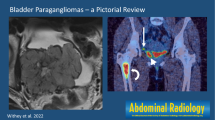Abstract
Bladder pheochromocytomas (PCCs) are rare tumors that account for 0.06% of all bladder tumors and makeup 1% of all PCCs. Most PCCs are functional, and they secrete catecholamines that lead to clinical symptoms such as paroxysmal hypertension, headaches, palpitations, and sweating. However, some are nonfunctional and asymptomatic and are hence difficult to diagnose. Cystoscopy and biopsy should not be performed when bladder PCCs are suspected. They may provoke a hypertensive crisis if preventative antiadrenergic blockers are not administered prior to the procedure. The diagnostic workup begins with obtaining blood or urine catecholamine and catecholamine metabolite values to make a presumptive diagnosis of bladder PCC. Computed tomography (C.T.) and magnetic resonance imaging (MRI) are then used to localize and stage the tumor for surgical resection. MRI, due to its superior soft tissue resolution and the ability to use multiparametric MRI (mpMRI) to differentiate between layers of the bladder wall and from other bladder masses, is the optimal imaging modality to detect extra-adrenal bladder PCCs and determine locoregional staging. Once antiadrenergic medications are given, the tumor is resected, and the diagnosis is confirmed histologically. However, the differential diagnosis of bladder PCC often gets overlooked, leading to surgical resection in the absence of antiadrenergic medications, increasing the chances of a fatal hypertensive crisis. This makes MRI an essential diagnostic tool for staging bladder PCCs before surgery. This review discusses the indications for MRI in bladder PCCs and describes findings from these tumors on various MRI sequences and when to use them. We also discuss how MRI can differentiate bladder PCCs from other bladder neoplasms.











Similar content being viewed by others
References
Al-Zahrani, A.A., Recurrent urinary bladder paraganglioma. Adv Urol, 2010. 2010: p. 912125.
Dragović, T., et al., Unrecognised adrenergic symptoms and the delayed diagnosis of urinary bladder paraganglioma. Vojnosanit Pregl, 2015. 72(9): p. 831-6.
Zimmerman, I.J., R.E. Biron, and H.E. Macmahon, Pheochromocytoma of the urinary bladder. N Engl J Med, 1953. 249(1): p. 25-6.
El Alayli, A., et al., Functioning metastatic paraganglioma of the urinary bladder in a 10-year-old child. BMJ Case Rep, 2017. 2017.
Wong-You-Cheong, J.J., et al., From the Archives of the AFIP: neoplasms of the urinary bladder: radiologic-pathologic correlation. Radiographics, 2006. 26(2): p. 553-80.
Loveys, F.W., C. Pushpanathan, and S. Jackman, Urinary Bladder Paraganglioma: AIRP Best Cases in Radiologic-Pathologic Correlation. Radiographics, 2015. 35(5): p. 1433-8.
Kurose, H., et al., Paraganglioma of the urinary bladder: Case report and literature review. IJU Case Rep, 2020. 3(5): p. 192-195.
Li, W., et al., Diagnosis and treatment of extra-adrenal pheochromocytoma of urinary bladder: case report and literature review. Int J Clin Exp Med, 2013. 6(9):832-839.
Li, S., et. al., Unsuspected paraganglioma of the urinary bladder with intraoperative hypertensive crises: A case report. Exp Ther Med, 2013. 6(4):1067-1069.
Saha, A., et al., Paraganglioma of Urinary Bladder: An Uncommon Entity in Uropathology. Cureus, 2021. 13(8): p. e17265-e17265.
Male, M., et al., Differentiating Nonfunctional Paraganglioma of the Bladder from Urothelial Carcinoma of the Bladder: Pitfalls and Breakthroughs. BioMed Research International, 2019. 2019: p. 1097149.
Li, H., et al., Diagnosis and treatment of a rare tumor-bladder paraganglioma. Mol Clin Oncol, 2020. 13(4): p. 40.
Tu, X., et al., Incidental diagnosis of nonfunctional bladder paraganglioma: a case report and literature review. BMC Urol, 2021. 21(1): p. 98.
Priyadarshi, V. and D.K. Pal, Paraganglioma of urinary bladder. Urol Ann, 2015. 7(3): p. 402-4.
Verma, S., et al., Urinary bladder cancer: role of MR imaging. Radiographics, 2012. 32(2): p. 371-87.
Liang, J., et al., Bladder Paraganglioma: Clinicopathology and Magnetic Resonance Imaging Study of Five Patients. Urol J, 2016. 13(2): p. 2605-11.
Blake, M.A., et al., Pheochromocytoma: an imaging chameleon. Radiographics, 2004. 24 Suppl 1: p. S87-99.
Galgano, S.J., et. al., The Role of Imaging in Bladder Cancer Diagnosis and Staging. Diagnostics (Basel), 2020. 10(9):703.
Chang, C.A., et al., 68Ga-DOTATATE and 18F-FDG PET/CT in Paraganglioma and Pheochromocytoma: utility, patterns and heterogeneity. Cancer Imaging, 2016. 16(1):22.
Ibrahim, A.A., et. al., A rare case of urinary bladder paraganglioma documented by 18F-FDG PET-CT: Clinical and imaging features. Int J Case Rep Images, 2021. 12:101196Z01AI2021.
Fishbein, L., et al., The North American Neuroendocrine Tumor Society Consensus Guidelines for Surveillance and Management of Metastatic and/or Unresectable Pheochromocytoma and Paraganglioma. Pancreas, 2021. 50(4): p. 469-493.
Chung, A.D., et al., Suburothelial and extrinsic lesions of the urinary bladder: radiologic and pathologic features with emphasis on MR imaging. Abdom Imaging, 2015. 40(7): p. 2573-88.
Qin, J., G. Zhou, and X. Chen, Imaging manifestations of bladder paraganglioma. Ann Palliat Med, 2020. 9(2): p. 346-351.
Das, S., N.V. Bulusu, and P. Lowe, Primary vesical pheochromocytoma. Urology, 1983. 21(1): p. 20-5.
Wen, C.Y., C.T. Yu, and C.H. Hsieh, Atypical presentation of bladder pheochromocytoma. Ci Ji Yi Xue Za Zhi, 2017. 29(1): p. 46-49.
Urabe, F., et al., Combination of en bloc transurethral resection with laparoscopic partial cystectomy for paraganglioma of the bladder. IJU Case Rep, 2019. 2(5): p. 283-286.
Rodacki, K., et. al., Combined chemical shift imaging with early dynamic serial gadolinium-enhanced MRI in the characterization of adrenal lesions. American Journal of Roentgenology, 2014. 203(1):99-106.
Messina, C., et al., Diffusion-Weighted Imaging in Oncology: An Update. Cancers (Basel), 2020. 12(6).
Abdelsalam, E.M., Adalany, M.A., Fouda, M.E., Value of diffusion weighted magnetic resonance imaging in grading of urinary bladder carcinoma. The Egyptian Journal of Radiology and Nuclear Medicine, 2018. 49(2): 509-518.
Funding
No financial support/funding.
Author information
Authors and Affiliations
Contributions
All authors contributed equally to the conception and design of the study; to the literature review and analysis; and to drafting, critical revision, editing, and final approval of the final version of this article.
Corresponding author
Additional information
Publisher's Note
Springer Nature remains neutral with regard to jurisdictional claims in published maps and institutional affiliations.
Rights and permissions
About this article
Cite this article
Zulia, Y., Gopireddy, D., Virarkar, M.K. et al. Magnetic resonance imaging of bladder pheochromocytomas: a review. Abdom Radiol 47, 4032–4041 (2022). https://doi.org/10.1007/s00261-022-03483-8
Received:
Revised:
Accepted:
Published:
Issue Date:
DOI: https://doi.org/10.1007/s00261-022-03483-8




